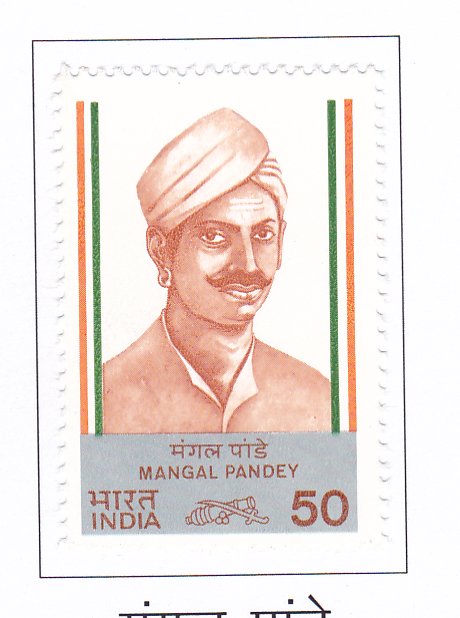Mangal Pandey (1827-1857)

Technical Data
| Stamp Set | India's Struggle for Freedom |
|---|---|
| Date of Issue | May 10, 1984 |
| Denomination | 50 p |
| Quantity | 1,500,000 |
| Perforation | comb 13 x 12¾ |
| Printer | Security Printing Press, Nashik |
| Watermark | No Watermark |
| Colors | Multicolor |
| Catalog Codes |
Michel IN 992 Stamp Number IN 1055 Yvert et Tellier IN 806 Stanley Gibbons IN 1124 |
| Themes | Famous people | Freedom Fighters | Headgear | Men | Revolutionaries |
India’s Struggle for Freedom: Mangal Pandey
Mangal Pandey, a pivotal figure in India’s struggle for independence, was born in Ballia, Uttar Pradesh. He served as a soldier in the British East India Company’s army during the mid-19th century.
Background and Context
During Mangal Pandey’s time, the British East India Company introduced new Enfield rifles to its Indian soldiers. These rifles used cartridges that were greased with animal fat, a highly sensitive issue for both Hindu and Muslim soldiers, as it violated their religious beliefs. To load the rifles, soldiers had to bite off the ends of these cartridges, which was abhorrent to their religious principles.
The Mutiny at Barrackpore
In March 1857, inspired by his comrades in Behrampur, Mangal Pandey refused to use the greased cartridges. His defiance escalated into open mutiny on March 29, 1857, at the Barrackpore cantonment near Calcutta (now Kolkata). He incited his fellow soldiers to join him in rebellion against the British authorities.
Confrontation and Arrest
Mangal Pandey’s mutiny quickly drew attention from British officers and guards. On March 29, 1857, he was confronted by British forces, and in a desperate attempt to evade capture, he attempted suicide by shooting himself. Though he survived, he sustained serious injuries.
Trial and Execution
Following his capture, Mangal Pandey was court-martialed on April 6, 1857. He was charged with treason and inciting mutiny against the British East India Company. Despite efforts to defend himself, he was sentenced to death. On April 8, 1857, Mangal Pandey was hanged at Barrackpore.
Legacy and Commemoration
Mangal Pandey’s brave actions sparked widespread rebellion across India, marking the beginning of the Indian Rebellion of 1857, often referred to as the First War of Independence. His courage and sacrifice became a symbol of resistance against British imperialism and inspired countless Indians to join the struggle for freedom.
The Indian Posts & Telegraphs Department honors Mangal Pandey’s contribution to India’s freedom struggle by issuing a commemorative stamp in his memory, alongside other prominent freedom fighters.
This account captures the essence of Mangal Pandey’s role in the Indian struggle for independence, highlighting his courage and the impact of his actions during a critical period in Indian history.
